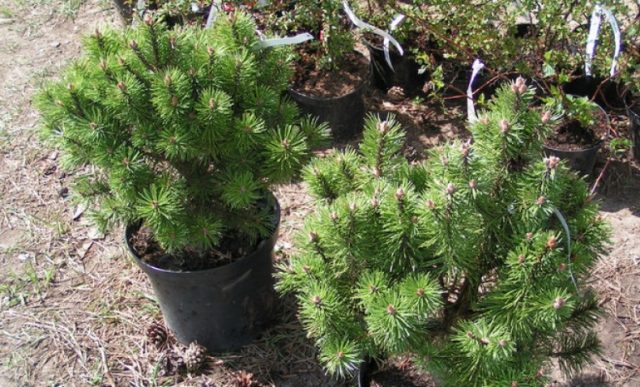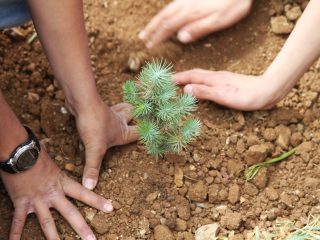Content
Elfin cedar is one of the forms of woody plants with a varied crown. Because of its structure, dwarf dwarf is considered a shrub, “half-bush, half-tree.” Clusters of plants form creeping forests.
Description of cedar elfin wood
Cedar dwarf is a compact plant. The cup-shaped crown is formed by branches widely spread to the sides. The trunk is covered with dark brown bark. There are light spots and slight flaking on it. The branches have gray smooth bark. They are pressed to the earth's surface, only the ends of the branches are directed upward. Newly growing shoots of dwarf cedar are initially colored green and have dense pubescence. Over time, they acquire a brown color.
The needles are long - up to 8 cm, have a triangular structure, and are bluish-green in color. The needles on the branches are placed in bunches of 5 needles.
After pollination, the cones ripen only in the 2nd year. They are small and oval in shape. The length of the cones reaches 7 cm, the width is 2 times less.
The dwarf cedar produces small, brown, oval-shaped nuts with a thin, woody rind.The length of the nut is no more than 9 mm, the width is up to 6 mm.
The seeding period begins after 20 or 30 years.
The root system grows in a unique way. First, dwarf cedar forms the main root and a system of lateral roots. Gradually the central root dies. The plant develops lateral roots located on the surface. Over time, they become overgrown with a layer of moss and become buried. In their place, dwarf cedar forms adventitious roots. Branches touching the earth's surface are also capable of forming adventitious roots. The formation of a system of adventitious roots makes the tree tenacious and hardy.
The wood of the plant is dense and difficult to split. It has many resin passages and a pronounced pine aroma.
Distribution of dwarf cedar
The dwarf cedar is a representative of the tree flora, adapted to poor soils and low temperatures.
The root system is located close to the surface, so permafrost does not affect the distribution of dwarf cedar. Since the form of the plant is creeping, dwarf cedar survives low winter temperatures under the snow.
The tree's growing range is extensive. It lives in the Far East and is found in Eastern Siberia. In the north, its thickets extend beyond the Arctic Circle. In the south, continuous thickets form in mountainous areas at an altitude of 800-900 m above sea level. In open areas it forms independent thickets, sometimes serving as the lower tier for larch forests.
Use of cedar elfin wood
Cedar elfin wood has decorative characteristics.Due to its decorative properties, it is used for landscaping areas and populated areas.
It is also valued for its numerous products obtained from plant parts:
- Pine nuts serve as a source of high-quality oil. Halva, filling for sweets and cookies are prepared from the cake. Whole nuts are eaten.
- Solid wood is used to make crafts.
- Trunks, branches, and roots are used to produce resin and turpentine.
Cedar elfin wood contains many biologically active substances. Therefore, products based on it are widely used for medical purposes. Turpentine is used to treat:
- colds and respiratory diseases;
- excretory organs;
- skin diseases.
Young shoots are used to heal wounds. Since ancient times, young branches have been used to treat scurvy.
A dye, usually green, is obtained from pine needles.
In nature, dwarf cedar is used to strengthen slopes and screes. They make plantings along the roads.
Designers began to use the plant for landscaping and decorating gardens. Cedar elfin wood is suitable for decorating alpine slides and hedges. Among conifers, this plant produces the most phytoncides. These substances kill pathogens. Therefore, just being nearby and inhaling the aroma of the ephedra is very useful. In the European part of Russia, dwarf cedar is still not widespread.
Growing dwarf cedar from seeds
Cedar dwarf can be propagated by seeds. For this you need seed material. It is purchased in specialized stores. If possible, you can collect the cones yourself, germinate them, get sprouts, and subsequently seedlings.
To do this, stratification is first carried out.That is, nuts are kept at a temperature of 2 to 5 degrees for 6 months. Then they are placed in moist soil at a distance of 2 cm. There is no need to cover them with soil. Moss is placed on top of the soil. It should be moist. In the future, the moss will retain soil moisture. Seed germination is low, so it is better to plant more of them.
Planting and caring for dwarf cedar in open ground
Unpretentious to low temperatures, it reproduces and grows slowly. Requires the creation of optimal conditions.
Preparing seedlings and planting area
To place the dwarf cedar, choose the right place. In nature, the plant lives on any soil. Therefore, special preparation should not be carried out here. If the soil is purely sandy, add clay. There must be more of it than sand.
Since the roots of dwarf cedar are shallow and the branches creep, there should be plenty of space for planting.
When choosing a seedling, pay special attention to the roots. They should be whole, moist and with a lump of earth. The branches should be flexible, without signs of damage. The height of the seedling is at least 15 cm.
Landing rules
It is recommended to plant dwarf cedar from April to the second half of May. During dry autumn - from late August to early September. Placing a seedling on a site requires following a number of rules:
- Preparing the planting hole. Its depth should be significantly greater than the height of the seedling itself - 80 cm. The width of the prepared place should be 2-3 times the size of the earthen clod.Drainage is placed in the lower part of the pit: large or small crushed stone, gravel, or other material. Sand is poured onto the drainage layer - 20 cm is enough. Then the hole is filled to the edge with a soil mixture: turf soil, sand, special soil.
- Before planting, it is recommended to place the root part in a 3% solution of potassium permanganate for 2 hours. This procedure will prevent possible diseases.
- When filling the hole with soil mixture, pour out a bucket of water. After the elfin tree is planted, 2 more buckets are poured out. The roots must not be allowed to dry out.
- A dwarf cedar seedling is placed in a prepared place with a lump of earth. It is advisable to carry out all work carefully, without damaging the roots. If the seedling is planted correctly, the root collar should be level with the ground.
- When planting several plants, leave a distance of 3-4 m between them.
- The surface of the planting pit is mulched with sawdust, pine bark, and special material. The mulch layer is 8 cm.
Watering and fertilizing
The dwarf cedar tree is rarely watered. During the warm season, one bucket per month is enough. If the weather is hot and dry, increase watering by 1.5 times. It is recommended to spray the needles with cold water.
Mineral fertilizing is carried out with a special composition “NPK 15-15-15”. This is a balanced fertilizer from the MINERAL line. The first fertilizing is carried out in April. Then every month they fertilize with a liquid humic composition of the same line. In the absence of these compositions, use nitroammophoska at the rate of 40 g per 1 m2. Fertilizer "Kemira Universal" is added 20 g per bucket of water.
Trimming
The dwarf cedar tree needs sanitary pruning. To do this, diseased and damaged branches are removed in a timely manner. For landscaping purposes, excess branches are cut off in the first ten days of April.The cut areas are treated with garden varnish.
Preparing for winter
The elfin tree is not afraid of harsh winters, but a little preparation for the cold season is needed. The roots are covered with 8 cm of straw or peat. In areas with heavy rainfall, the crown may be damaged by large amounts of snow. To protect it, a pyramid-shaped frame is made from the bars and covered with any material.
Reproduction
The dwarf cedar reproduces slowly. For this use:
- ready-made seedlings purchased in specialized stores;
- seeds;
- layering.
If possible, you can use layering for propagation. This method requires an adult tree. Roots form where the branches touch the ground. It is enough to separate part of the branch and move it to another place.
Diseases and pests
Elfin cedar is a tree with good immunity. But some diseases and pests can still affect it:
- Hermes Siberian is a pest that feeds on tree sap, slows down its growth, and reduces its decorative characteristics. Identified by a white coating on the needles. For treatment, dwarf cedar is treated with insecticides. The method of microinjection into the trunk is used. Repeated treatments are carried out.
- Pine needle rust – a disease in which yellow formations in the form of bubbles appear on the needles. The needles of the affected tree fall off. As treatment, diseased branches are removed in a timely manner. Dwarf dwarf trees are sprayed with immunostimulants and watering is combined with the application of microfertilizers.
- Schutte mushroom – affects plants that do not tolerate shade well. In spring, the needles become orange-brown in color with small black growths. Diseased branches are removed. For prevention in spring and autumn, a solution of Bordeaux mixture is used.In case of severe damage, treat with the drug "Hom".
- Aphid – a pest that attacks young plants. As a preventive measure, it is recommended to destroy ants, as they contribute to the appearance of aphids. Insecticides "Aktara", "Decis" and others help.
- Shchitovka – when damaged by the pest, brown round-shaped formations are noticeable on the needles and branches. Young shoots become bent and die. If the number of pests is small, they are collected manually. In case of severe damage, treat with solutions of the same insecticides.
Conclusion
Cedar dwarf is an evergreen coniferous tree with decorative properties. The plant does not require much care. Once you plant this tree, you can decorate the area in an original way and for a long time, as well as take advantage of the beneficial properties of the plant.











